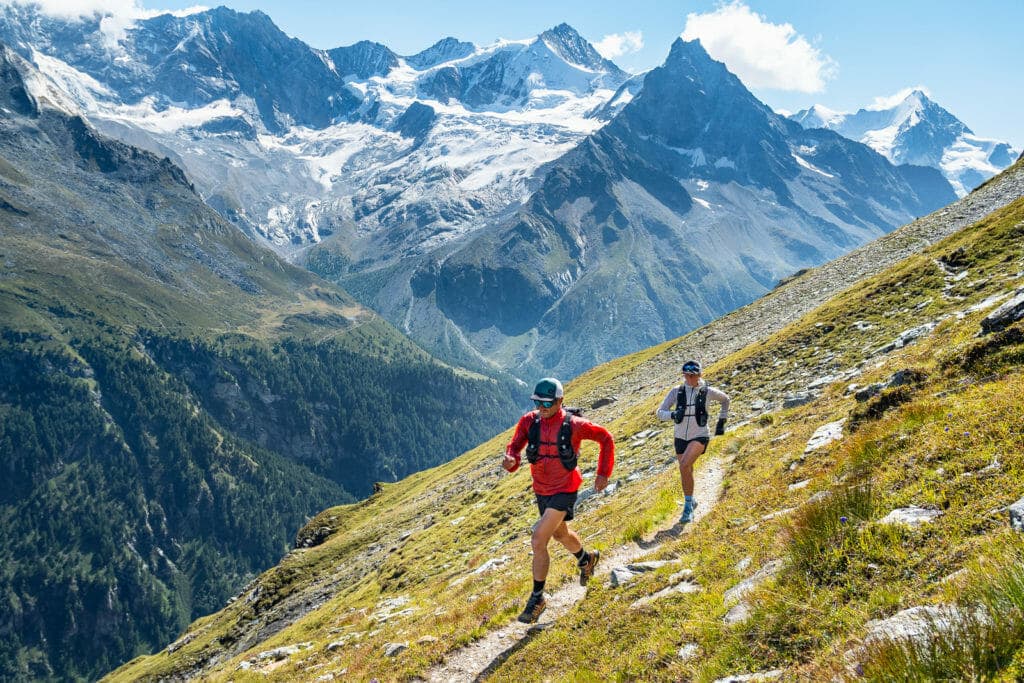

Via Valais: It’s Way Better than Running the Haute Route
The Via Valais
Haven’t heard of it? Even so, you’ve probably seen photos of long and winding single track through high grassy pastures with towering snow-capped peaks in all directions. If some stunning alpine view made you stop scrolling through social media or flipping magazine pages, that just might have been the Via Valais.
The ALPSinsight / PatitucciPhoto team of Dan and Janine Patitucci, and Kim Strom (also content producer for Run the Alps), conceived of the idea, designed the route, and created the tour. In an interview with Run the Alps, professional mountain sport photographer and athlete, Dan Patitucci, shares some of the details of making the Via Valais, where the idea came from, and how it’s going now.

Run the Alps: Let’s start with – what is the Via Valais?
Dan: The Via Valais is a multi-stage trail running tour linking Verbier with Zermatt through the Valais region of the Swiss Alps. It’s 225km with 14,000 meters of vertical gain. It is NOT a race or an event; it is a dream route that motivated and fit trail runners can do either on their own or as part of a guided group.
We originally broke the route into nine stages, but also decided to adapt a shorter version for people who needed to fit the tour within one week or to make it a bit easier. (Run the Alps offers a version of this shorter tour. You can read about it here.) And to make it harder, we added a bonus peak to each day’s itinerary. We wanted there to be some options for different skill and fitness levels.

Run the Alps: What kind of trail running abilities and skills should you have to be able to run the Via Valais?
Dan: The route is for trail runners who want a lifetime goal, and it is going to take some fitness and preparation. It’s just the right amount of not too difficult, but it’s also not for the underprepared. The days average about 25km with 1500 meters of gain. These aren’t huge days, but there are nine of them stacked together. And the climbs and descents are steep, which take a toll on the body.
Runners embarking on the Via Valais should have a solid base of fitness, ideally some prior experience in the Alps to not underestimate the impact of steep terrain, and a sense of managing their body to get through consecutive days of mountain running.

Run the Alps: How did you develop the Via Valais route?
Dan: We dreamed up the idea while creating the Run the Alps Switzerland guidebook. After running all through the Swiss Alps for the book, we came to realize that much of our favorite trail running terrain in the Alps was in the Valais region. The trails are smooth, the views are loaded with stunning alpine scenery, and the villages and huts provide an ideal infrastructure to support multi-day trail running tours.
The skiers and hikers have their Haute Route, which also passes through the same Valais mountains, but trail runners didn’t have a tour specially adapted to their needs.
We wanted a tour where we could run, so we sought out trails that contoured in and out of the valleys separating Verbier with Zermatt, and after about a month of exploring, voila, we had found the passage.
At that point, back in 2018, we ran the tour in full and it was perfect.
Run the Alps: Looking at maps, the Via Valais roughly follows the famous hiker’s Haute Route from Chamonix, France to Zermatt, Switzerland. It’s not the whole route, but other than that, how is doing the Via Valais different from deciding to trail run the traditional Haute Route?
Dan: The hiker’s Haute Route connects Chamonix with Zermatt, but the trail goes straight up and straight down everyday. It is a relatively direct line on trails that doesn’t suit a runner’s idea of a quality trail. Runners want more flow and terrain that will allow long sections of cruising, and descents that aren’t just steep knee pounding lines.
We also didn’t like the entire Prafleuri section of the hiker’s Haute Route and wanted to avoid this area with the human impact on the environment and an old, dirty hut.
Essentially, the Via Valais parallels the Haute Route, crosses it or shares it for a few short sections, but is very much an independent line. The full Via Valais has an option to cross a glacier, goes over a high alpine pass (the Schöllijoch), and traverses high above Zermatt for a dramatic finish.

Run the Alps: The Via Valais has gotten a lot of attention. Why do you think that is?
Dan: As professional photographers, we did a lot of our commercial and editorial work on sections of the Via Valais, which further introduced it to an outdoor audience. It’s been featured in various European Runner’s Worlds, Trail Runner, and is now the setting of a great story by Chris Solomon in Outside Magazine. We shot an entire Patagonia project on the trail, and one of those images was the first time the Patagonia catalog cover was trail running. This summer, Black Diamond is releasing a film about how we created the Via Valais with some stunning footage that’ll have people rushing to their devices to learn more.
The Via Valais exploded on social media (#viavalais) and runners from all over the world took notice. We worked really hard to make the best possible images of the tour to catch people’s attention and clearly it worked. But we also had some pretty famous mountains, like the Matterhorn, doing some of the work for us.

Run the Alps: What makes the route special to you? Any favorite sections?
Dan: My wife Janine did most of the route design. Kim and I developed it from a business standpoint, created the online guide on ALPSinsight, and made it what it is. Growing the route from an idea to a reality makes it very special for us. Now seeing people have incredibly good experiences on it is the best result we could imagine.
A favorite section? For me it’s our stage 7, Turtmanntal to Randa, with the bonus peak summit of the Barrhorn.
Run the Alps: What’s next for you three?
Dan: In 2021 we developed our second multi-day tour in the Alps, the Via Grischuna. It’s a much easier 7-stage tour in Eastern Switzerland’s Graubünden region. We also produced Sierra Trail Runs : A Guide to the Eastside, which is an online resource to trail running in California’s Sierra Nevada and a photo guidebook due out in 2022. So, more running.

Via Valais in the press
There’s so much more to read about the Via Valais. Here’s a few examples to make you want to run it for yourself.
Run the Via Valais with Run the Alps
Go Guided or Self Guided on the Via Valais, our Grand Tour of the Alps! This high-mountain route has been designed specifically with trail runners in mind. You’ll traverse valleys, run over high passes, and through meadows on your journey from Arolla to Zermatt.
*The Run the Alps guided and self-guided tours of the Via Valais are adapted from the original 9-Stage Via Valais shown on ALPSinsight’s online guide. Our route differs from their original routes, to allow for more frequent baggage delivery, help fit the tour into your vacation time, and avoid a technical high mountain pass.